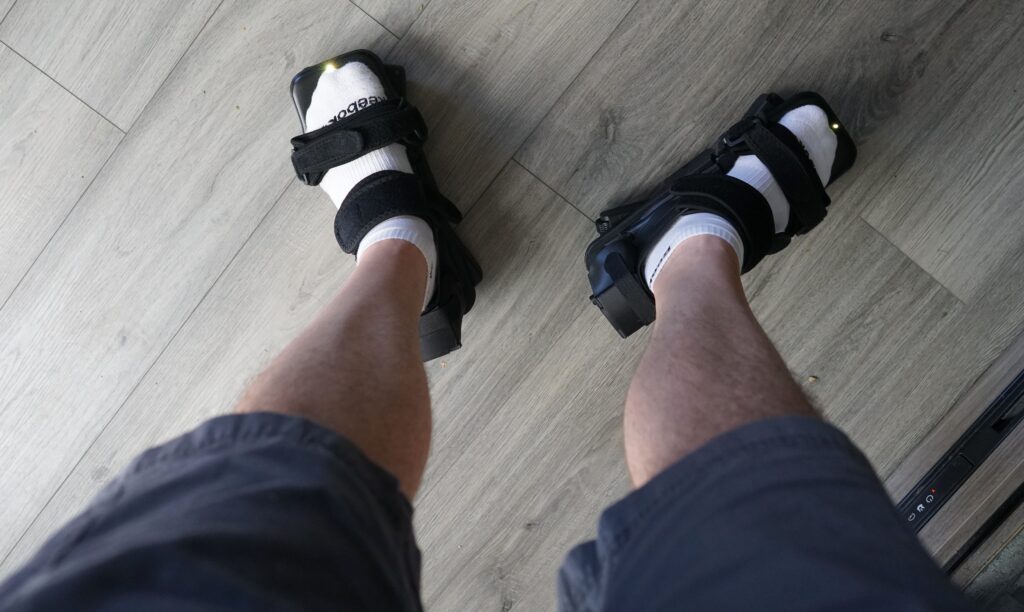Walking in virtual reality has always presented a unique challenge. Whether you’re confined to a small play space, forced to teleport, or endure the stomach-churning “smooth joystick movement,” true immersion often takes a hit. For many, the teleport mechanic, while breaking immersion, is preferable to motion sickness. But what if there was a better way? What if the very act of walking naturally in VR could be integrated into a funky pair of shoes? That’s precisely the question Freeaim sets out to answer.
The Tech Underfoot: How Freeaim Works Its Magic
Traditional VR locomotion solutions, like omni-directional treadmills (ODTs), often confine you to special bases that direct you back to a center position. These can be large, cumbersome, and prohibitively expensive, with enterprise-level ODTs costing upwards of $50,000. Freeaim, however, subverts this status quo by developing wearable tech that can be targeted to everyday folks.
The Freeaim VR Shoes are essentially motorized omni-directional shoes. They are designed with a groundbreaking concept: as you walk forward, the shoes actively move your feet backward, effectively keeping you in place within your physical space while allowing you to move endlessly in the virtual world. This “active VR locomotion device” aims to be the go-to solution for fully immersive walking.
Packed into each shoe—which, at 2-3 lbs each, are not subtle — is a wealth of technology. I like to compare them to Japanese Geta sandals with motors resembling Jawa sand crawlers. The tech includes:
- Motors, servos, and batteries: Powerful, quiet motors provide the omni-directional movement, while servos direct you to center (Advanced version).
- Microcontrollers, IMUs, and other sensors: These track your movement precisely.
- Firmware: The code that runs directly on the shoes.
- Driver Software: Code that runs on your VR PC to interface with the shoes.
- Mobile App: For configuring the shoes.


Sound complicated? It is! Fortunately, you don’t need to really know how they work. The hard work is already done. Just take off your normal shoes, strap your feet in, adjust the straps and heel, and be prepared for some adaptation. They definitely take some getting used to.
The shoes work with any SteamVR-supported VR headset and most PC VR games that have walkable environments. Freeaim’s intention is for them to eventually pair like a gamepad to work with any headset, including the Meta Quest, by mimicking a directional pad. While you can move in different directions, speed isn’t fully supported (just walk for now), and you cannot go backward currently. The technology also includes “Positional Correction,” an innovative feature that helps users stay centered in their playspace, ensuring a natural walking experience.
My Hands-On Experience: A Journey of Re-learning to Walk
My journey with the Freeaim VR shoes began with a visit to Alex Evans, Freeaim’s head of software and user experience. The humility of his title belies his crucial role in the prototyping and design. He happens to be located within a reasonable distance of me so I was excited to have a chance to meet him.
Considering all that he’s done, Alex is a friendly, unassuming guy who just loves inventing high-tech shoes! When I arrived, he was in the middle of capturing more imagery for the upcoming Kickstarter campaign. He has a pair of the shoes out near a high-end VR-ready gaming PC. There’s also what appears to be a flattened bent-metal frame of some sort against the wall.
Strapping into the shoes, held snugly by two Velcro straps, was the first step. Unpowered, they felt awkward, but once Alex powered them on via his mobile app, they lit up and made a sound. This is where the real learning began.

For safety, Alex set up the hexagonal support frame of his design (those tubes against the wall). He kept repeating, “just walk naturally,” a seemingly simple instruction that proved surprisingly difficult. My gait, as video evidence later showed, was anything but natural, making C-3PO look graceful. It took some getting used to, especially with the prototype frame’s base bunching up.
To turn them on, Alex had an app on his phone (more of his code). He said they connect using both 2.4 and 5GHz connections (not Bluetooth) for the best in speed and low-latency. The shoes lit up and made a sound. He dialed in a treadmill mode and said I could stand up and give them a try. For safety though, he took that metal frame from against the wall and expanded it into a six-sided support structure (also his design). At this point, no headset is involved. All I have to do is walk. I thought I knew how to walk. Time to relearn!

After about ten minutes in a treadmill tutorial mode, it was time for the true test: VR immersion. Alex switched the support to a more rigid swivel frame, which offered full body support like a traditional VR treadmill but with real walking. This frame is heavier, around 50 lbs, compared to the hex frame’s 35 lbs, but is also foldable for compact storage.
I started with VR Walking Simulator. Not one of our favorites, but a good choice for wide areas to move around in with no gameplay elements to distract you. I started walking and quickly had issues with changing direction. It turns out I was leaning forward in a way that interfered with the frame. Once again I was in my own way! I started getting better, so I decided it was time to switch to another experience: Half-Life: Alyx. I love this game and was hoping that being able to move naturally would increase the immersion. I tried! I really did. I was able to use it to move and even change direction, but an hour wasn’t enough for me to get really good. Alex said some players can learn them properly in 15-30 minutes.
Pricing and the Road Ahead
These consumer shoes will become available on July 15th through their Kickstarter campaign. Early-bird discounts will let you snag a “Light” pair for $1079 or the “Advanced” for $1399. The Light version lacks the servos so works best with the frame to keep you in place.
While I, personally, can’t see spending over $1,000 for the experience, it’s a very personal decision. The device firmware and driver software are expected to improve, and with practice, users can even get to a point where they don’t need the frame at all. Many VR gamers have been eagerly awaiting a compact solution like this. I wish them the best with their campaign!








Leave a Reply